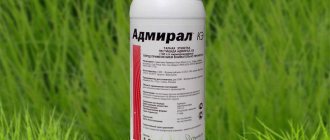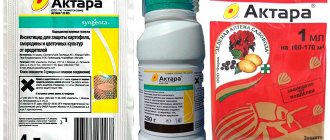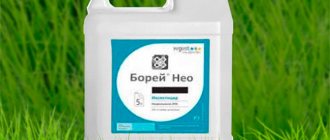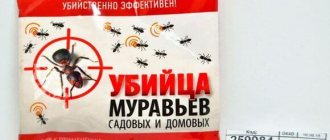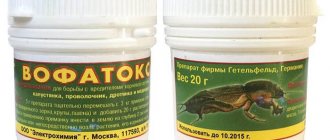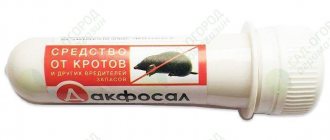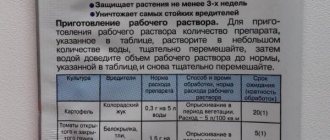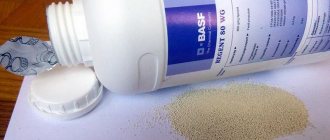Author: Elena N. https://floristics.info/ru/index.php?option=com_contact&view=contact&id=19 Category: Insecticides Published: December 12, 2011Republished: February 12, 2019Last edits: March 12, 2021
If you need a drug that can destroy all kinds of pests on fruit trees and berry bushes, on vegetable beds and melon fields, on garden and indoor flowers, turn your attention to the insectoacaricide Actellik. Those who have already worked with this drug have probably been able to appreciate not only the effectiveness, but also the speed and versatility of its action. And for those who have not yet used Actellik, we will try to describe its advantages and disadvantages in as much detail as possible.
Purpose
Actellik is a contact, intestinal and fumigant insecticide with a broad spectrum of action that protects plant crops from a complex of sucking and leaf-eating pests - flower beetles, sawflies, thrips, aphids, whiteflies, cutworms, Colorado potato beetles, codling moths, weevils, fungus gnats, tea moths, spider mites . The drug is also used for pre-sowing treatment of seeds, disinfection of storage facilities and the surrounding area.
Advantages of Actellik over other drugs:
- wide scope of application – protection of plants, buildings, storage facilities and healthcare facilities;
- high efficiency in destroying many types of pests, including in hard-to-reach places and at high temperatures;
- high rate of pest suppression;
- long-term effect of the drug;
- ease of use.
Disadvantages of the drug:
- a pungent odor that can linger in the apartment for up to two days;
- toxicity of fumes;
- instability in alkaline and acidic environments;
- with repeated treatments, resistance may appear;
- effective for pest control, but not for preventive measures;
- high consumption of the drug when treating plants in open ground, which is not cheap.
Efficiency of use for plants
The developers of Actellik offer gardeners to provide effective protection against pests. Insect control is allowed on all types and types of soil. Suitable for 90% of crops (ornamental, vegetable, garden).
It is considered a drug created to achieve a quick effect, which allows you to preserve the plant for a long period of time at any stage of development without damage.
Actellik's instructions indicate the advantages and disadvantages of the product. There are recommendations for all forms of release: ampoules and canisters. The nuances of use apply only to working with liquid in a residential environment. Reasons: high toxicity of the drug - hazard class 2.
Actellik is rightly called a universal liquid. Has a wide spectrum of action. The treatment can be carried out not only in the vegetable garden or garden. Work in flower beds, barns, and granaries is allowed.
The toxic solution destroys pests quickly and effectively thanks to a unique component. Eliminates flyers and creeping insects.
Combination with other fungicides and insecticides is possible. When using Actellik for indoor plants, you will need to follow safety rules.
The principle of action for all types of crops is the same: after entering the digestive organs of an insect, an effect on nervous regulation occurs. To kill the parasite, it is enough to inhale the sprayed product. The superiority over similar drugs is undeniable.
Interesting fact! The chemical can be used to treat not only premises, but also furniture, walls, and metal structures. The instructions indicate the possibility of eliminating blood-sucking parasites. Such as bedbugs, cockroaches.
Effect of the drug
The active ingredient of Actellik is pirimiphos-methyl, which belongs to the class of organophosphorus compounds - FOS. Getting directly onto the parasite or onto the plant on which the pests feed, Actellik causes dysfunction of various organs in the pests, which leads to poisoning of the entire body. The drug is able to penetrate deep into leaf tissue and destroy mining pests. Due to its fumigating action, Actellik affects even those parasites that are hidden on the underside of the leaves and have avoided direct contact with the working solution. However, the fumigating property appears only if at the time of treatment the air temperature is not lower than 15 and not higher than 28 ºC.
Actellik is one of the most powerful non-systemic drugs, and usually one or two treatments are enough to destroy pests, but if you still find surviving parasites, it is better to carry out a control spraying with Iskra, Inta-Vir, Vertimek, Aktara or Arrivo:
- Reviews about the use of insecticide Karate Zeon
- firstly, Actellik is too “fragrant” and toxic,
- secondly, by the third time the pests may develop resistance.
Actellik is available in 2 ml ampoules and 5 liter canisters. An analogue of Actellik is the drug Kamikaze.
Recommendations and conclusions
The drug "Actellik" is one of the strongest insecto-acaricides. Yes, it is effective, but at the same time it is not safe.
Therefore, you should:
- is especially attentive to safety standards when using it;
- be sure to use personal protective equipment;
- It is strictly forbidden to use the drug during the flowering phase of plants;
- buy a drug from an official manufacturer, beware of counterfeit goods and imitations;
- comply with the drug dosage and release time.
*** Changes and additions were made on July 13, 2019.
Instructions for use Actellik
Dissolve the contents of the ampoule (2 ml) in 2 liters of water. A solution of this concentration can be used to treat young plants, the number of parasites on which is small. If there are a lot of pests and the plants are mature, the solution should be twice as strong, that is, 2 ml of Actellik is dissolved in 1 liter of water.
Spraying of crops in open ground is carried out on a dry and windless day, early in the morning or after 18:00. For work, a fine spray is used, which does not produce splashes, but fog. Ground organs of plants must be moistened evenly, while preventing the solution from dripping from the leaves and stems. It is advisable to re-treat after 5-7 days. The protective effect of the drug in greenhouses lasts from 7 to 14 days, and in open ground from 2 to 3 weeks.
| Culture | Pest | Solution consumption | Max. number of treatments | Days until harvest |
| Strawberries, currants, gooseberries, raspberries | Sawfly, aphids, weevils, moths, etc. | 1.5 l per 10 m2 | 2 | 20 |
| Peppers, tomatoes, eggplants, cucumbers | Thrips, aphids, whiteflies, mites, etc. | Open ground – 2 liters per 10 m2; protected soil – 1 l per 10 m2 | 2 | 20 |
| Floral and ornamental crops | Aphids, mites, whiteflies, thrips, scale insects, etc. | Open ground – 2 liters per 10 m2; protected soil – 1 l per 10 m2 | 2 | 20 |
| Carrots and cabbage | Pest complex | 1 l per 10 m2 | 2 | 30 |
| Peach | Aphids, codling moths, scale insects, etc. | 2-5 l per tree | 2 | 50 |
How to use Actellik correctly: dilution and spraying
More often on the packaging they write how to dilute the substance for the garden. However, for home flowers it is diluted in the same way.
You will need to carry out two treatments: one sanitary and the second control. Allow a week between them.
- The temperature of the diluted drug should be moderate (from 15 to 20 degrees), so it is stronger.
- If there are few parasites, dilute the ampoule in 2 liters, if there are many - in a liter.
- First, it is diluted in half the normal amount of water, then water is added.
- Before treating the flowerpots, cut off the leaves that will not recover and burn them along with the embedded bugs.
Security measures:
- At least just remove pets from the room and cover the aquarium.
- Treat the leaves so that the poison gets into each area.
- But don’t spray too much—you don’t want the solution to flow from the flower into the ground.
- One ampoule is enough for 2 liters of solution (although, of course, Actellik also comes in larger packaging). If you have diluted less, it is better not to store the remains in the apartment (the poison will evaporate, and the organisms of your loved ones will not like it), but to throw it away. And not in the trash, but immediately take it to the trash can.
- At the end of the work, ventilate the room well, even in cold winter.
- In summer, it would generally be wise to spray poison on flowers, taking them outside (if there is no balcony, then into the yard).
Actellik can be mixed with fungicides (only units rich in copper are not suitable - for example, Bordeaux mixture).
And here is what one of the manufacturers writes on a small bag of poison:
Precautionary measures
- It is undesirable to stay in the room where plants were treated for a long time, since the drug has a high vapor pressure.
- You cannot prepare the working solution in food containers.
- Children and animals should not be present when plants are treated with Actellik.
- It is forbidden to drink, eat and smoke while working with the drug.
- It is necessary to use protective equipment: respirator, goggles, gloves, special clothing.
It is not known exactly how long the half-life of the active substance takes: according to some sources, the process lasts 11-15 weeks, according to others – no more than 2-3 days. Therefore, precautions are so important both during the procedure and after it. After completing the work, you need to wash your hands and face with soap, rinse your mouth, and also treat the surfaces with which the product came into contact with soap and water: shelves, glass, window sill. Protective clothing, goggles and masks should also be thoroughly washed and washed.
Compatibility and analogues
There are no restrictions on the compatibility of the drug "Actellik" with other insecto-acaricides.
So, if repeated treatments are necessary after the period of protective action has ended (up to 2 weeks), it is better to use the drug “Actellik” together with the drugs “Vermitek” or “Aktara” . This technique will disrupt the insect’s development cycle and provide more effective crop protection.
The drug "Actellik" is well compatible with biological products due to its low level of persistence. However, the drug is not compatible with Bordeaux mixture and drugs containing copper and its derivatives.
Persistence is the ability of pesticides to resist the decomposing effects of physical, chemical and biological processes in environmental objects.
As analogues of the drug, we can note the drugs “Fitoverm” , “Vermitek”, “ Aktara” , “Kamikaze”, “Biotlin” , “Karbofos” , “Iskra”, “Commander”, etc.
First aid
The recommendations below are intended only for providing FIRST aid, after which you should immediately consult a doctor and follow his instructions! DO NOT SELF-medicate!
- The victim should be taken out into fresh air at the first signs of poisoning: weakness, vomiting, nausea, malaise.
- If Actellik gets on the skin, remove the drug from the skin with cotton wool or a cloth, being careful not to rub it, and rinse this area of the body with running water or a weak soda solution.
- If Actellik gets into your eyes, you need to rinse them under running water for 15 minutes, keeping them open.
- If the drug has been swallowed, but the victim is conscious, you need to give him 5-6 tablets of activated charcoal with several glasses of warm water and induce vomiting. Attention! Do not induce vomiting if the victim is unconscious. You need to call a doctor and show him the drug label!
Actellik's antidote is the specific cholinesterase reactivator atropine sulfate, or P-2AM, but do not use it unless prescribed.
After providing first aid, consult a doctor immediately!
Advantages and disadvantages
Actellik insecticide is popular among gardeners because it has the following advantages:
- destroys various types of garden insects;
- not only fights pests, but also prevents the appearance of new ones;
- preserves the harvest;
- it is easy to use, the main thing is to follow the instructions;
- It is inexpensive - its price is 25–30 rubles per ampoule.
The disadvantages of this drug include:
- Toxicity. It belongs to the second class of danger, that is, it is harmful to fish and bees.
- Has a pungent odor.
- To treat vegetable gardens you will need a large amount of the drug, which will be quite expensive.
Reviews
Vasiliev: The drug has proven itself as a remedy against stock pests. I managed where other pesticides failed. It’s a pity that Actellik is still a bit expensive, but sometimes you pay more for worse quality, so it’s a shame to complain.
Seluyanov: an excellent drug, very effective against literally all pests both in the greenhouse and in flower beds. And after treating the indoor flowers, the smell disappeared quite quickly. But the price is steep.
Anna: Actellik helped me cope with mealybugs on indoor plants. True, I almost suffocated because I carried out the treatment in the bathroom. Next time I will do it on the balcony.
Maryana: I brought a sofa from a friend and after a while I discovered that it was infested with bedbugs. I don’t know what I would have done if it weren’t for Actellik. I treated the sofa, locked the room and did not enter it for a week, and when I moved the sofa away from the wall, I discovered more than a hundred dead parasites.
- Two proven preparations for healthy seedlings - how to prevent pests and diseases from appearing on seedlings?
Evgeniya: the drug, of course, is deadly, but I won’t use it in the apartment anymore. For indoor plants I’ll look for something less smelly, but in the garden you can use Actellik: the drug is strong, one spray is enough to kill all the pests.
Official website and manufacturer's recommendations: https://www.syngenta.ru/products-crop-protection-insecticides
They used it: reviews from flower growers
Here is some worldly wisdom that flower growers shared with me on the forums:
- I make the concentration of the substance 2 or even 3 times lower than for vegetables. It helps, but it stinks less and less toxins are released into the house.
- The substance did not suit all colors. At least the orchid was okay, but the begonia almost died.
- And I’m afraid of this poison, even though it’s high quality. If there are few insects, just wash all the leaves with soapy water. It’s better to do three such flushes than the children will breathe in something they don’t understand.
- I would not recommend it to allergy sufferers. Even with good ventilation. For four days after the treatment I felt like that unfortunate poisoned tick. Even when the leaves no longer smelled of anything, I still felt sick for a couple of days and had a headache.
- And after processing, I put a bag on the plant. Transparent so that there is no sun. And it hardly stinks, and this way Actellik works more accurately.
- One flower grower explained to me that even when a flower stops smelling like Actellik, dangerous evaporation continues for another three days from it (leaves, soil). So if I bully, I keep the plants on the balcony for a week and forbid children to enter there. Well, I don’t keep rolls with potatoes there, of course.
- I missed it, and the mite attacked all the pots standing on the balcony in the summer. I sprayed them, as well as the entire closed balcony (even the floor), with this substance, closed the windows and left the house for three days. Before this, the tick kept coming back, but now it has disappeared completely.
- And I not only spray the flowers, but also spill the soil with Actellik. This helps better. Why be afraid - these are not potatoes! But the substance does not harm flowers.
Above, I have already described how to dilute liquid insect repellents. How to store them after breeding? You will learn the opinion of an experienced florist from this video:
And in this video you will see the process of treating an orchid against mites. Please note: the girl covered her face with a towel:
Description
Actellik is produced by the Swedish company Syngenta Crop Protection Co, which specializes in the production of plant care products for gardening.
Initially, Actellik was used to treat warehouses against pests, but later the range of its use expanded, and the drug became an indispensable assistant for gardeners.
The drug Actellik is characterized by an enteric contact action, provoking the death of plant pests through the penetration of the toxin through their integument and digestive system.
Recommendations for use
The instructions for use contain clear safety instructions when using the chemical:
- To prepare the solution, you must use special containers and also use personal protective equipment.
- Avoid contact with mucous membranes.
- The total time of working with the chemical should not exceed 2 hours.
- Visiting treated greenhouses, barns and warehouses is not allowed for 3 days.
- Upon completion of work, it is necessary to thoroughly wash personal protective equipment, as well as the face and hands with soap.
In what cases is it used
An important advantage of the insectoacaricide Actellik is a wide range of pests that die due to the use of the enteric contact agent of the FOS group. An important point is the destruction of ticks and insects after treatment.
The following are sensitive to the action of pirimiphos-methyl:
- whitefly;
- scale insect;
- spider mite;
- cabbage scoop;
- fungus gnats;
- Colorado beetle;
- weevil;
- tea moth;
- flower beetles;
- aphid;
- thrips and other pests.
Emulsion concentrate and wettable powder are used:
- for the destruction of garden and vegetable pests, insects and mites that have settled in the greenhouse, greenhouse, and indoor flowers;
- for preventive purposes: to protect plants of all listed groups from attack by pests.
List of orchid pests and methods of controlling them
If a gardener sees bugs, midges, or larvae swarming around, he must immediately take action. How and with what to treat an orchid against pests largely depends on the type of insect or mite. A heavily infected plant will have to be thrown away.
List of typical orchid pests:
- Spider and armored mites.
- Mealybugs and root bugs.
- Scale insect and false scale insect.
- Whiteflies.
- Thrips.
- Aphids.
Treat indoor plants against insects and mites using a sprayer (“sprayer”). Use ready-made liquid products, diluted concentrates, granules and soil sticks for spraying. Contact pesticides should get onto the integument, while intestinal pesticides should get into the digestive system of the pests with the eaten plant.
Below is a list of orchid pests with a detailed description and how to combat them.
Aphids on an orchid
Small insects suck sap from different parts of plants, transmit viral diseases, and create a favorable environment for the proliferation of sooty fungus. An aphid attack on an orchid is recognized by sticky spots, deformed leaves, fallen unopened buds and dried flowers. Pests form colonies under leaves, on flowers and on the tops of young shoots.
Aphids on an orchid
Aphids are sedentary insects 1–5 mm long. The body is oval in shape, colored in shades of green, pink, brown or black. There are wingless and winged aphids that lay eggs and are viviparous. Females are very fertile - producing more than 100,000 young in one month.
How to get rid of aphids on an orchid:
- Immediately wash the infected plant with a stream of water;
- wrap your fingers in a bandage and remove insects from the affected organs;
- in case of significant infestation, treat with a suitable insecticidal preparation - Fitoverm, Iskra or Aktara;
- repeat spraying after a week, use a different pesticide.
Nettle infusion is a folk remedy for aphids on orchids. Prepare from two handfuls of fresh leaves and 2 liters of cold water. Leave for 12 hours, filter, pour the solution into a spray bottle and treat the plants. The folk remedy works within a week.
You can replace nettle with celandine grass, marigolds, dried tangerine or orange peel, and dry tobacco leaves. It is recommended not only to spray the infected orchids with the prepared infusion, but also to “walk” along the lower surface of the leaves with a soft brush. After 15 minutes, the treated areas are washed with clean water.
Spider and armored mites
The diameter of the oval body of the pest is less than 1 mm. The integument of spider mites is usually light green, orange or red-brown in color. Adults and larvae have a piercing-sucking type of mouthparts. Limbs - 4 pairs (aphids and other insects have 6 legs).
Spider mite
You can recognize spider mites on an orchid by the appearance of dots and pale yellow spots on the leaves. Pests weave webs around young shoots and buds. When mites multiply en masse, the leaves dry out and the entire orchid dies. Some species carry pathogens of infectious plant diseases.
The red spider mite is the most dangerous for orchids. Females are very fertile and lay eggs in a warm room all year round. It is useful to use a cold shower against spider mites. You can water the flower generously, cover with a transparent waterproof bag to increase humidity (remove after 3 days).
Pests are destroyed by spraying with Actellik. Rinse the pot with the drug solution and water the soil. There are other acaricides that are relatively safe for people: Fitoverm, Aktofit, Vertimek.
Decoctions of tobacco leaves and Dalmatian chamomile are destructive for ticks. The plants must be dried, finely chopped and left for 12 hours in cold water. The effect of folk remedies is short, so they are used mainly for prevention.
Armored mite
The orchid mite appears as a tiny shiny ball on the protruding roots and lower parts of the shoots. These arachnids feed on dying parts of plants. A large colony of oribatid mites switches to feeding on young leaves of phalaenopsis and dendrobium.
The method of controlling soil pests is to transplant plants into a healthy substrate. Before the procedure, it is necessary to clean the roots from mites. Use Aktellik or Fitoverm for soil etching. Another simple method is to periodically dry the substrate.
Thrips
Adult insects have an oblong body 2.5 mm long and live on the soil surface. Thrips on orchids look like tiny black sticks with small wings. Females lay eggs on leaf blades.
You can recognize an orchid infestation with thrips by yellow spots with dots on the leaves and brown necrotic areas on the shoots. The larvae feed on plant sap, which they suck from leaves, buds, and flowers. To examine insects at this stage of development, you need to use a magnifying glass.
Pests enter a room with infected orchids or other plants, or bouquets of flowers. It is necessary to quarantine for two weeks for each new pet in the green corner.
Thrips on an orchid
The fight against the spread of thrips involves improving the light regime and using insecticides. Effective drugs - Aktara, Insektor. A solution of systemic pesticides can not only be sprayed, but also watered on the substrate. The active substance penetrates through the roots into all organs of the plant.
Among biological products for treatment against thrips, it is recommended to give preference to Vertimek and Fitoverm. Spray orchid leaves on both sides, shoots, and aerial roots with an insecticide of biological origin. The disadvantage of biological products is the need for 2 or 3 treatments over 7–10 days.
Folk remedies have low effectiveness against thrips. Often, the use of decoctions and infusions of herbs takes time, but does not lead to the desired result. In case of severe damage, the sequential use of two different insecticides is required: first chemical, and after a week biological.
Shchitovka
The shield aphid is a dangerous pest of orchids. A sign of infestation by this insect is the appearance of small brown scales or waxy tubercles and sticky secretions on the leaves and stems. It is difficult to remove an adult pest - it literally digs into plant tissue.
Shield aphid
The insect's body length is from 1.5 to 4 mm. Wings develop only in males, but the oral apparatus is reduced. Large females do not have legs or wings. The wax-like shield protects well from the penetration of chemicals through the integument into the body.
Scale insects and false scale insects are combined into one superfamily of coccids or scale insects - sucking insects that are dangerous to many plants. Pests of orchids - 4–5 types of scale insects, soft false scale insects. Controlling this group of insects is extremely difficult.
Before getting rid of scale insects on an orchid, you need to isolate the affected specimen from healthy plants. Then you should remove all the brown tubercles. It is recommended to change the substrate, disinfect the pot and treat the orchid with Actellik. Next, a second and third treatment will be required at intervals of 5–6 days.
White bugs
Several orchid pests, such as mealybugs, fit this description. The long-tailed or bristly bug is a reddish-gray bug covered with a whitish “powder”. The insect has an oval body up to 4 mm long with white waxy threads.
Mealybug on an orchid
The color of other species is white, light brown or pinkish. Infestation can be recognized by “cotton balls” and brown spots on the leaves. Insects not only feed on the sap, but also inject their saliva with toxins into the plant tissue.
There will be a long fight against mealybugs on orchids, since after treatments eggs remain and new generations emerge. Particularly susceptible to attack by the pest are Phalaenopsis pleasant and Lady's slipper. Mealybug larvae hide behind the scales of Cattleya violation pseudobulbs.
The presence of soil pests of this group in the soil can be recognized by ashen-colored lumps on the surface of the substrate. Various species of the orchid family are susceptible to infection by mealybugs from the genera Rhizoecus and Geococcus.
If there are white bugs in orchids, what should you do? Collect insects and replant the plant in fresh soil. To remove scale insects from leaves, you can use diluted vodka or calendula tincture. A hot shower (45°C) is destructive to pests and relatively safe for plants.
If soil scale insects are detected, the orchid must be transplanted into a healthy substrate. Spray heavily infected plants with Actra, Actellik or Iskra. The roots are treated with a weak solution of an insecticidal preparation.
Whiteflies
Small white midges in orchids spread quickly and infect almost all plants in the collection. Whiteflies are small insects with folded wings. The top of the body seems to be covered with a layer of white powder.
Whitefly
Infestation by these insects causes leaves to turn yellow and fall off. Under the influence of a pest, the plant becomes more susceptible to fungal, viral and bacterial infections.
They begin the fight against whiteflies by replacing the substrate in pots and removing affected leaves. Plants are treated with Aktara, Fitoverm or Aktellik. The soil is watered with a weaker solution of one of the drugs. Fitoverm is effective only with repeated treatments or in combination with other insecticides.
Norms and dosages
The concentration and consumption of Actellik working solution is determined individually each time. The basic value for calculation in all cases is the consumption of the product (CE) per unit of treated area. The calculation is based on the nature of the lesion - severe or massive; Actellik is not used for routine preventive treatments due to its short duration of action and high toxicity. A pest attack is considered severe when 25% or more of the crop is lost or its share, making the affected crop unprofitable in the current environment. A mass lesion is one that can destroy plants irreversibly.
Instructions for using Actellik for plant protection are given in Fig. in tables:
According to general standards (in the first figure), the consumption of the product (CE) for a given affected area and the volume of its purchase are determined. Lower values are taken for pests with permeable body covers; large ones - for those with tight skin. Then, based on the purchased volume of EC, the amount of seed water for preparing the mother solution is determined at the rate of 50 ml of water per 1 ml of EC. After this, based on the size of the area to be treated, the volume of the working solution is determined for severe damage (table on the next figure) or mass (figure below).
Note: information about Actellik compatibility is in the footnote to the table. in the last fig. are incorrect. Actellik loses activity in both alkaline and acidic environments. Water for preparing its solutions must have an acidity pH = (6.6-7.2).
If more than 2-3 liters of working solution is required, then prepare it in portions, because the seed level in the working vessel should be at least 3-4 cm. A portion of seed water is poured into a vessel (glass, polyethylene or propylene), a dose of CE is introduced into it and stirred. After this, a surfactant is introduced (if used), it is also stirred, and also while stirring, the seed is mixed with water to the volume of the working solution. Immediately before starting work, the sprayer with a filled tank is shaken vigorously several times, because highly diluted CE Actellica quickly separates and sticks together into flakes.
Current questions about the drug "Actellic"
Question No. 1. Is it possible to mix Actellik in the same tank mixture with fungicides?
Can. For example, the experience of Mordovian farmers from the private farm “Orlova K.N.” is described. They treated their crops with a mixture of Actellica and Switch fungicide. As a result, it was possible to avoid damage to the fruit by fruit drosophila and preserve its marketability for a long time.
According to the regulations published on the website, it is compatible in tank mixtures with almost all pesticides, except those that have an alkaline reaction. You also need to be careful when mixing it with drugs that come in the form of wettable powders.
Mechanism of action on parasites
Actellik is a non-systemic insecticide. The type of its effect is intestinal contact. The penetrating activity of the product is high, and therefore it allows you to effectively exterminate pests not only on the outside, but also on the inside of the leaf. The insecticide will enter the insect body along with food and through the respiratory system.
Depending on the type of plant, the quality of treatment, and also on what stage of development the pests are at, their death occurs in a period from 5 minutes to 2 hours. In rare cases - up to 12 hours. After treatment, indoor plants are protected by the drug for another 14 days. This allows you to prevent their re-infection if pests remain somewhere in the room.
Advantages and disadvantages
- Advantages - The scope of use of the chemical is quite wide. Highly effective. Characterized by high duration and speed of action. Easy to use. Protects against a complex of leaf-eating and sucking plant pests.
- Disadvantages - Toxic. Unstable in both acidic and alkaline environments. Repeated treatment leads to resistance. Not suitable for prophylaxis. Cannot be used at home. Cost of processing open soil plants.
